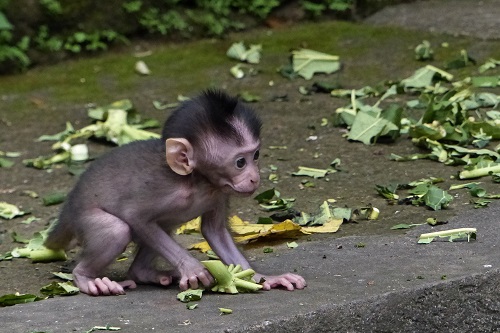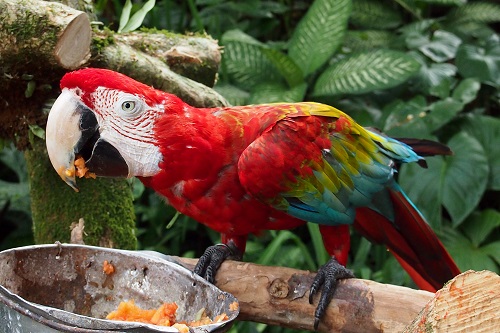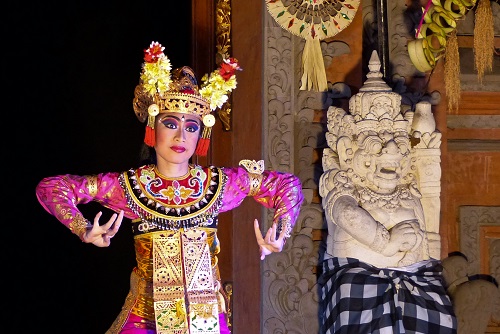With a petrol soaked whoosh the fire in the centre of the courtyard came to life. The dragon appeared, illuminated by the red glow of the roaring flames, and began to rustle and gyrate around the bonfire. A bloodcurdling roar split the air as the barefooted dragon charged through the fire, kicking up a hail of red hot sparks in a dazzling display. Again and again the burning debris was raked together and the dragon repeatedly ran through the flames, spraying ash and embers in all directions. When the fire was burning low, the dragon was finally slain signalling the end of the performance. This spectacular fire dance was an unexpected highlight of our time in Ubud, a town widely regarded as the cultural capital of Bali.

Balinese Dance
Nestled among the rice terraces of central Bali, Ubud is popular with those seeking a more traditional Balinese experience. Whilst it may be more authentically Balinese than the party town of Kuta, Ubud is still extremely touristy. There is however a definite focus on cultural activities. The number one attraction is Ubud's Sacred Monkey Forest. The collection of Hindu temples within the woodland are renowned for their cheeky primate custodians. The baby monkeys are particularly cute but it's the antics of the older, more mischievous monkeys that are most memorable. After the monkey forest, it's the numerous art galleries, craft shops and traditional dance performances that draw visitors to Ubud.
Read more about Goa Gajah, an ancient temple complex near Ubud.

Ubud Monkey Forest
Arts and Crafts in Ubud
The main streets of Ubud are dominated by arts and crafts shops and there is a dedicated art market in the centre of town. Colourful textiles, masks and paintings festoon the shop fronts and an endless tide of ceramics and statues encroaches onto the pavement. Our new friend, Suri, advised us not to buy any souvenirs in Ubud. Locals feel the products available in the centre of town are poor quality and overpriced. Some of the surrounding villages however are known for particular specialities. Nyuh Kuning is the place to find wood carvings and Penestanan is notable for its beadwork.

Blanco's Giant Signature
Ubud's Art Museums
Despite its small size, Ubud has numerous art museums. Antonio Blanco, also known as the 'Bali Dali', sounded like the most interesting artist so we ventured to his home. Built on land gifted to Blanco by the King of Ubud, his house, studio and family temple are now part of the Blanco Renaissance Museum. Blanco designed the museum building itself, which was finished in 1998 shortly before his death. A gigantic sculpture of his signature towers over the entrance to the museum forming a large marble gate. At 15 metres high it is the largest signature in the world.
Antonio Blanco was a mad, beret-wearing Spaniard. He seems to have moved to Bali mainly because at that time the local women tended to walk around topless. Naked females feature heavily in his paintings, including his adolescent daughter.
Blanco also indulged in poetry with his poems often integrated into his artwork. One painting featured a nude woman wearing a large round earring that was a sign of her virginity. One of her legs, which was hinged and wooden, obscured a poem beneath. Removing her earring, a somewhat phallic wooden plug, and inserting it between her legs was the only way to uncover the rest of the poem.

Blanco's Bird Collection
Balinese Dancing in Ubud
There are many variations of Balinese dance performances, often telling a story from Hindu legend. We saw Kecak monkey dance that involved dozens of performers chanting rhythmically. The monkey army capered and danced, continuously chanting cak, cak, cak, while Hanuman, the monkey god, played out the story with other lead performers.
In contrast to the primal, percussive Kecak performance, the dance of the Legong is much more refined. Heavy make up drew our attention to the expressive eye movements that were an integral part of the dance. This was accompanied by precise hand gestures and almost robotic actions. The disparity between the beauty of the dancers and their creepily unnatural motion gave the overall impression of a possessed puppet.

Legong

Rangda And The Barong
The most elaborate costume we saw belonged to the barong. This mythological creature is a huge shaggy animal with a bright red face and gnashing jaws. Its enormous golden headdress is adorned with mirrors making the barong glitter as it shimmies across the stage. Barong are benevolent guardian spirits who usually feature in tales of good versus evil, with the demon queen, Rangda, as the formidable opponent. Although it's supposed to be based on a lion, the barong behaves more like an over-excited puppy.
A visit to Ubud is not like stepping back in time to the good old days of traditional culture, poverty and poor sanitation. Much like the rest of Bali, Ubud is reasonably developed with a decent standard of modern living. The locals do however work hard to keep their traditions alive with Balinese dance, artwork and craftsmanship very much the focus of tourism in this area.

Ubud Travel Tips
For a free schedule of the Balinese dance performances in Ubud, ask at the Fabulous Ubud tourist information centre. It's located on the corner of Jalan Raya Ubud and Jalan Monkey Forest.
The restaurants on Ubud's main street, Jalan Raya Ubud, are touristy and often overpriced. There are small warungs down many of the side streets that offer better value Balinese food. We found a few good warungs on Jalan Arjuna.
It's easy to organise day trips and tours from Ubud. It's a popular pick up point for sunrise trekking up Mount Batur.

When I was in Ubud, I didn’t see the performance with the roaring flame and the dragon unfortunately. Sounds amazing though! We enjoyed the Kecak monkey dance though, and a performance of the traditional Balinese xylophone in an amazing restaurant garden containing a lake full of lilypads!
My friend who accompanied me to Ubud in 2016 told me that 20 years ago it was very different. It felt almost “undiscovered” back then, but now, in spite of still very much being the cultural capital of Bali, it is undeniably touristy. The phrase that sticks in my mind most when I think of Ubud is, “Hello, taxi?”
I loved the Monkey Forest.
I sadly didn’t make it to any art museums there, but spent a while browsing arts and crafts shops – the ‘Bali Dali’ museum sounds great.
Another highlight of Ubud for me was the gelato shops – OK, not traditionally Balinese, but they has really interesting fusion flavours made with local ingredients such as lemongrass. We had a favourite shop that we went to every day 😉
Hi Howell, Interesting to hear how much the vibe has changed. Ubud is firmly on the tourist map these days. Very glad they still have the dance performances because we really enjoyed them. Sadly we missed the gelato. We’ll know to look for it next time!